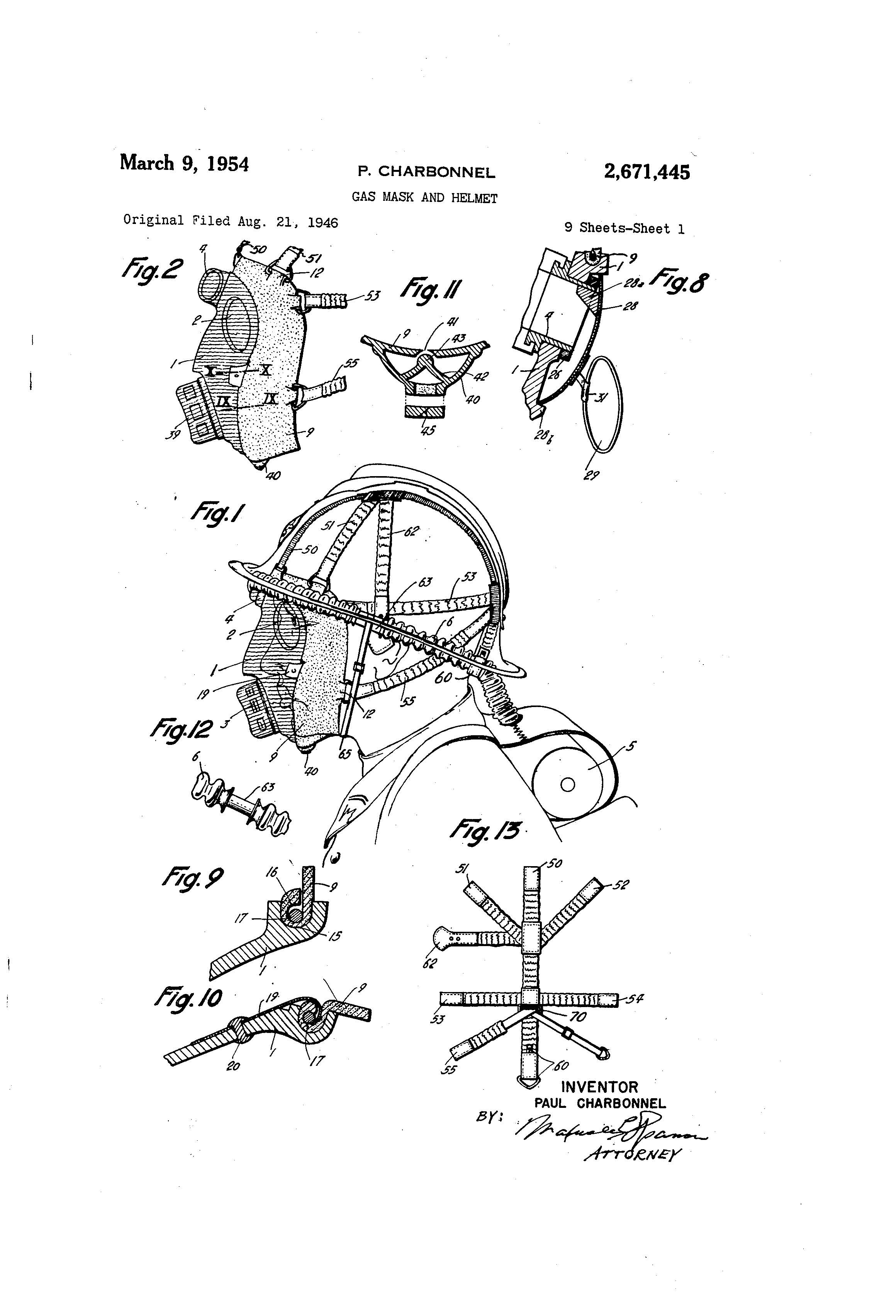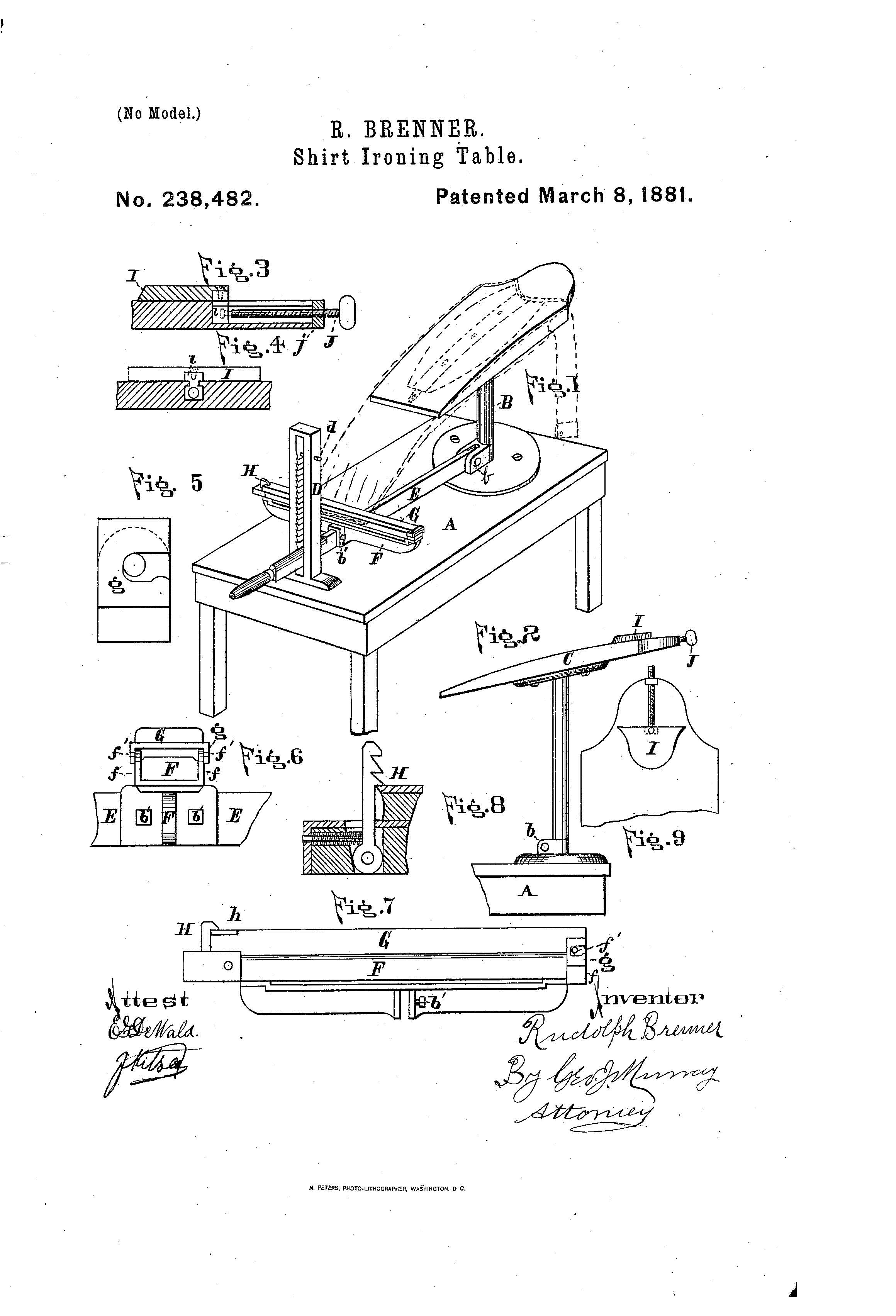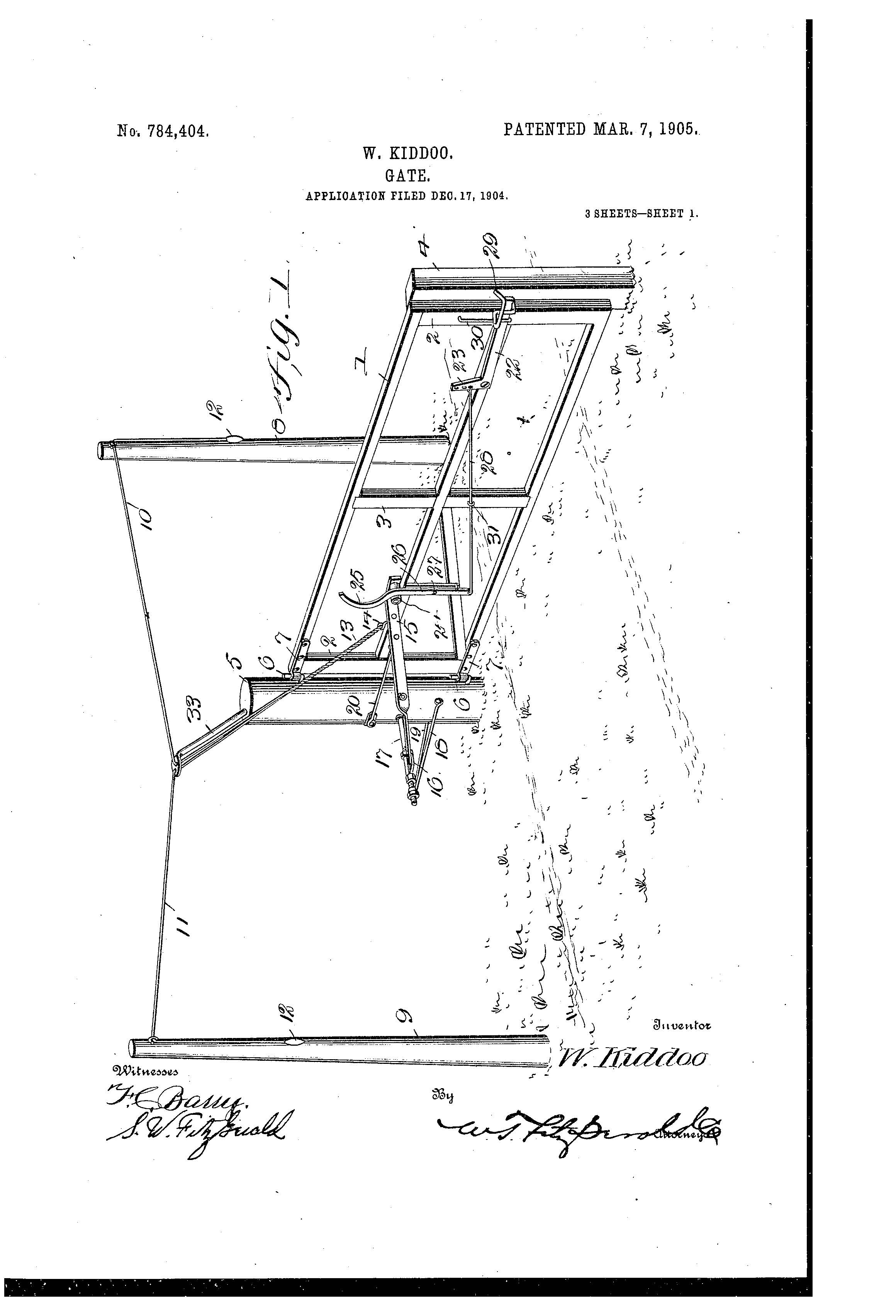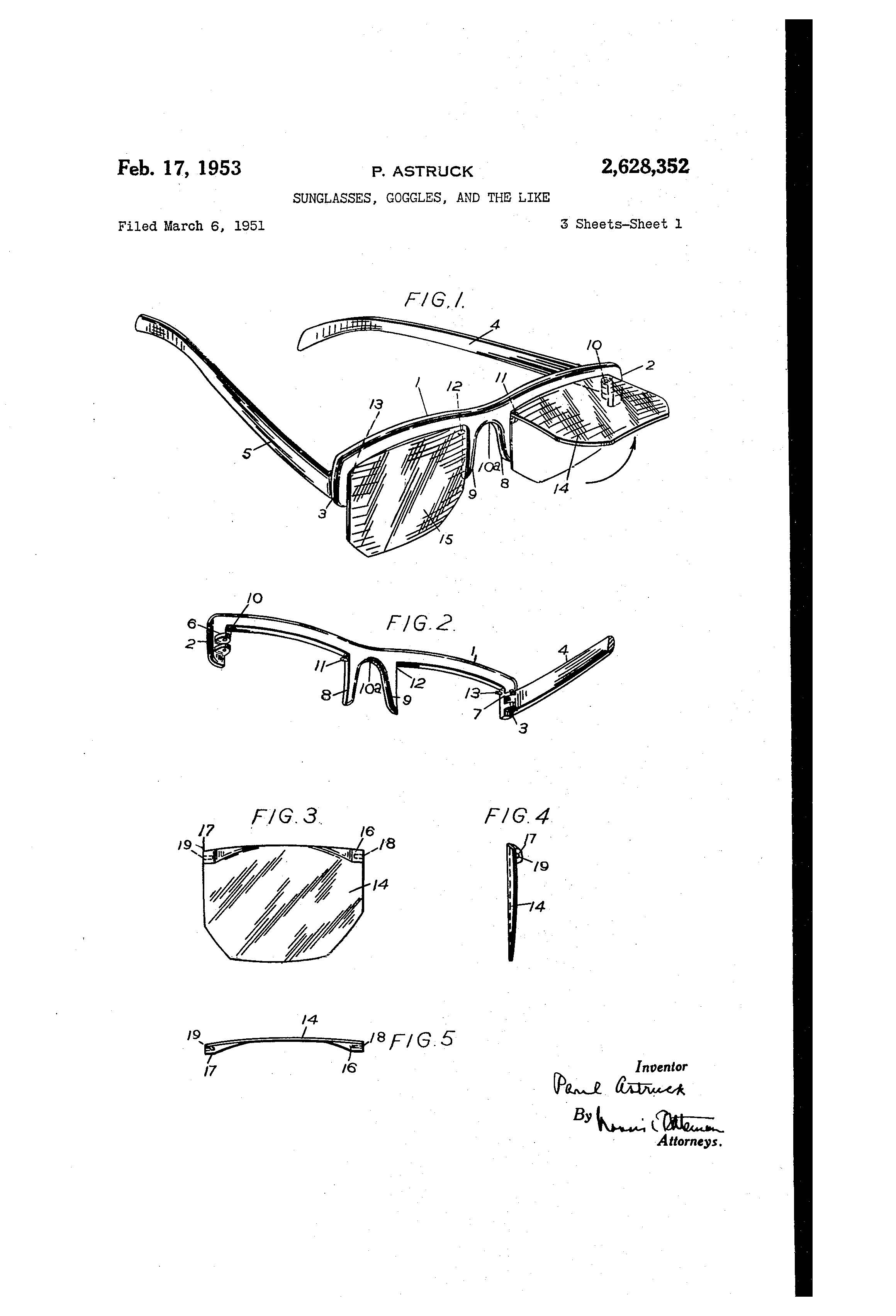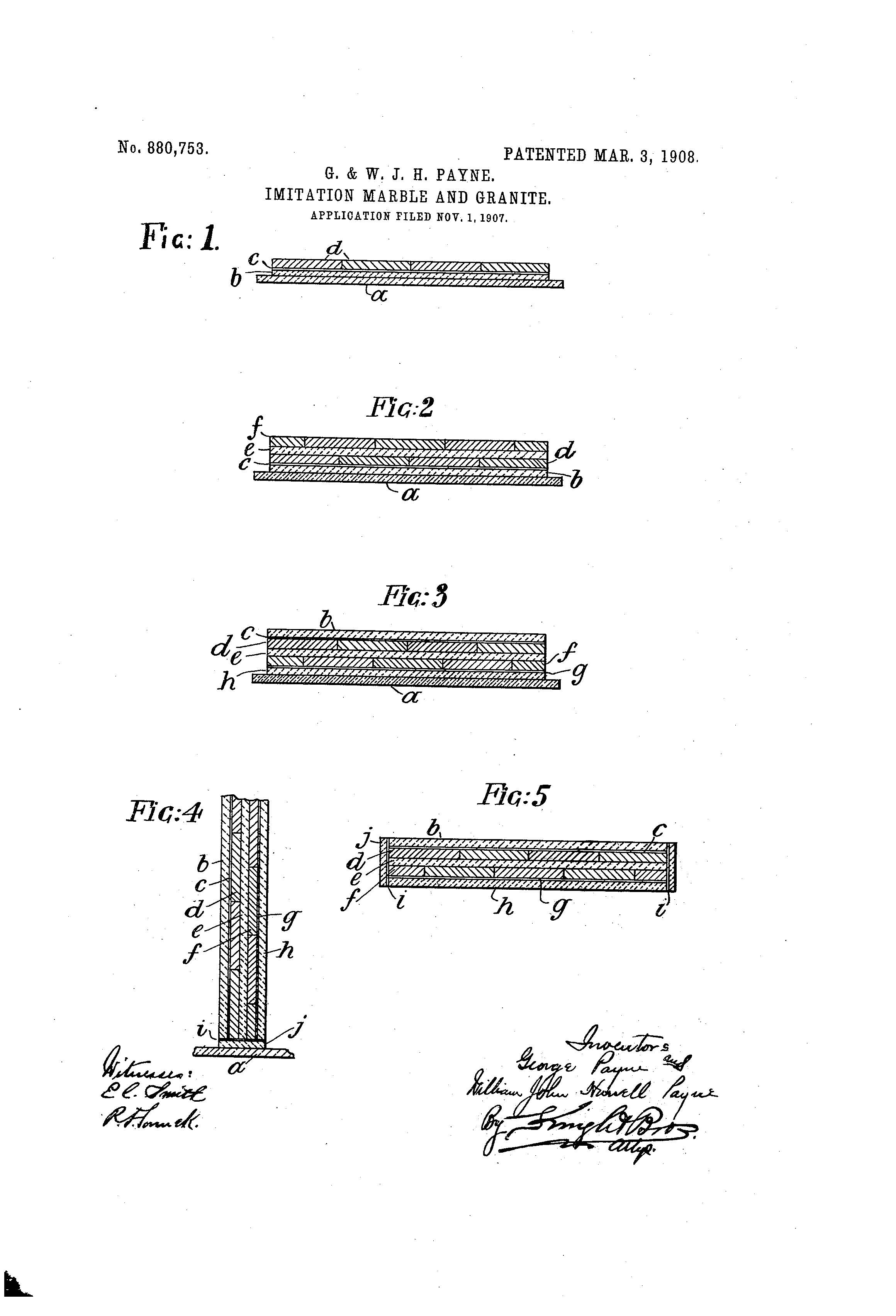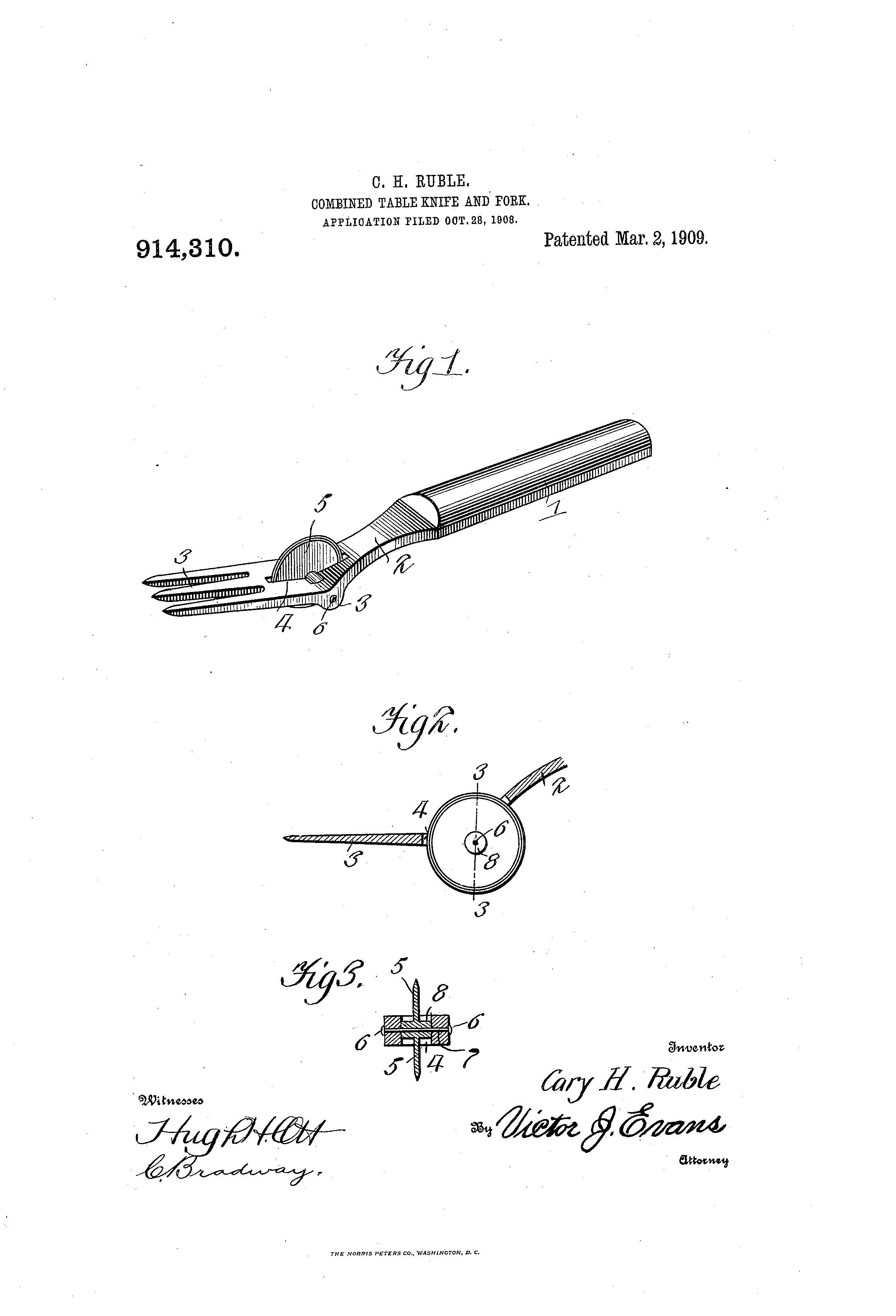Patent of the Day: Method of Roasting Coffee
Suiter Swantz IP takes a look back at past inventions and inventors with our Patent Of The Day.
On this day in 1904, THeodore R. Timby was granted U.S. Patent No. 754,943 for a METHOD OF ROASTING COFFEE.
In carrying out this method a quantitiy of coffee-beans is added in the drum and them the drum is hermetically sealed. Then the fire is lighted under the drum or the drum otherwise heated, and the drum is slowly rotated, so as to keep the coffee-beans agitated and prevent them from burning to the side of the cylinder or from browning unequally. By preference there should be stirring-arms, within the drum, so as to act as scrapers or mixers for the coffee. The temperature within the drum may be carried to some 400° or to the heat necessary to secure a thorough roast of the coffee-beans, and the roasting may be continued as long as may be necessary. When pressure is formed in the drum by the expansion of air and gases and by the expansion of the coffee-beans, an outlet is permitted for the excess of pressure, as follows: The shaft is hollow and has perforations inside the drum. Shaft 2 is connected by a suitable pipe, which in turn communicates through suitable valves and by passages with the strong reservoirs, the valves serving to close the passages between these reservoirs and the pipe, which leads to drum. When it is desired to relieve the pressure in the drum, one of the valves is opened, and the aromatic vapor from the coffee produced by the heating or roasting then enters said reservoir, being thus withdrawn from the drum. Preferably, however, the full pressure developed during the roasting is allowed to remain on the coffee-beans until the same are roasted to such degree as experience shows is best adapted for the particular grade of coffee under treatment. Then the heat is permitted to fall away until the coffee is quite cool. There may still be a pressure in the drum, and the gas will then be led off into one of the reservoirs and there penned and stored. The cooling of the drum may be effected by the removal of the fire from the drum or the drum from the fire, as desirable, and any known means may be used to hasten the cooling. After coffee-beans are roasted in the drum they may be further treated to pressure by opening one or more of the valves permitting the entrance of air or gases stored under pressure in the reservoir to flow into the drum and restore to the beans any of the lost aroma due to the roasting.
Coffee as usually roasted in an open vessel loses from fifteen to twenty per cent in weight. By this process there is little or no loss of weight, as whatever is driven out of the beans in roasting is restored by the pressure of air and aromatic gases in the process of cooling.
Suiter Swantz IP is a full-service intellectual property law firm serving all of Nebraska, Iowa and South Dakota. If you have any intellectual property questions or need assistance with any patent, trademark or copyright matters and would like to speak to one of our patent attorneys please feel free to contact us.
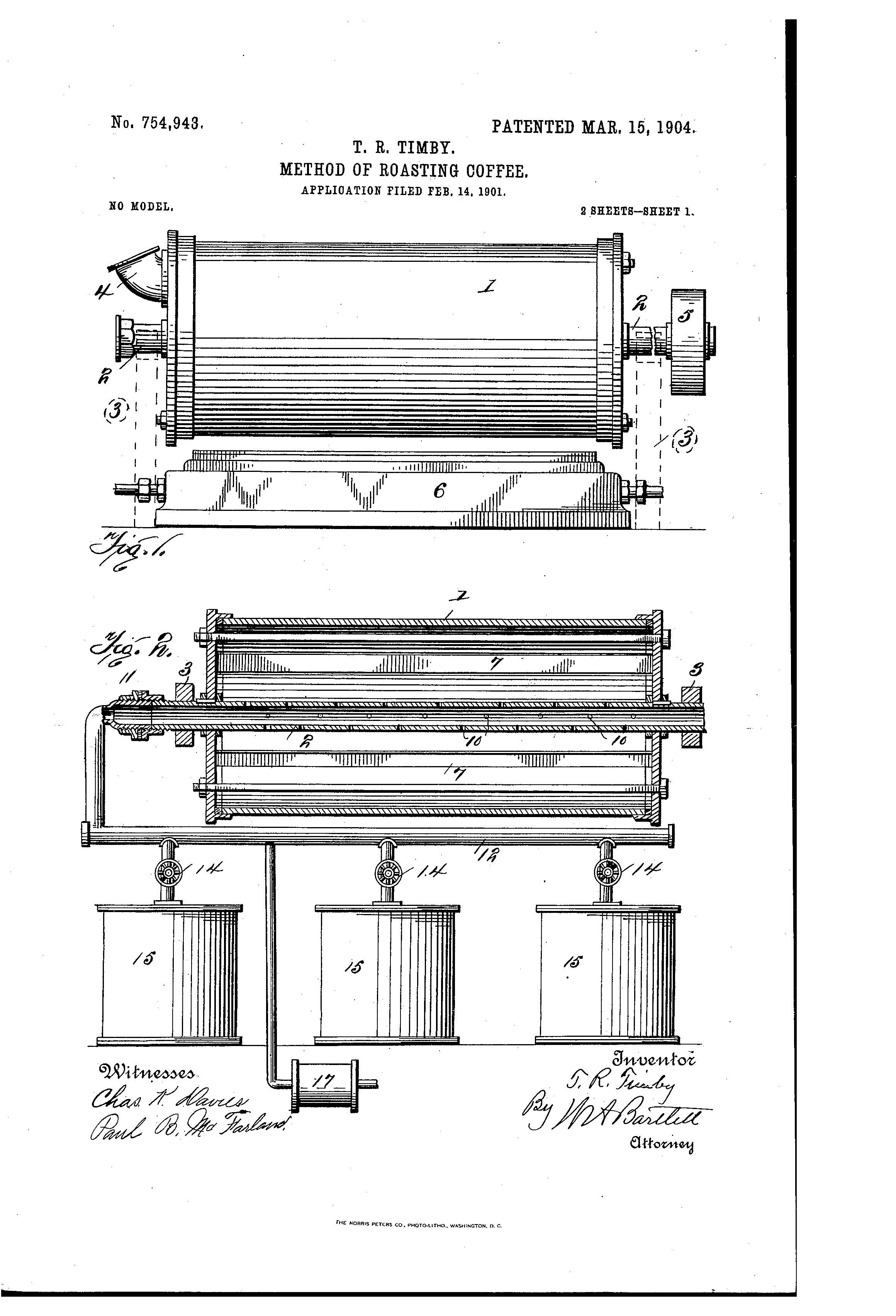
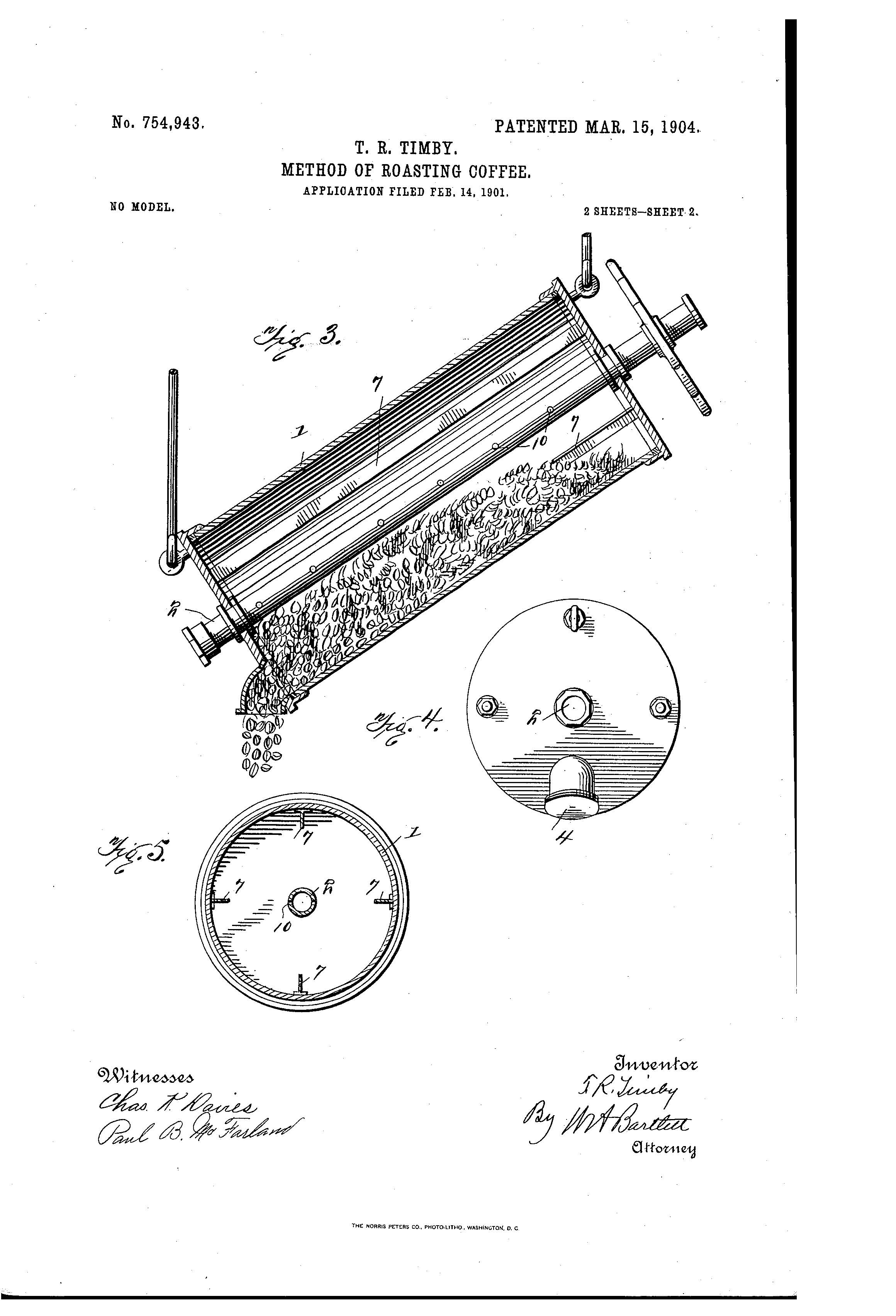
Patent of the Day: Cotton Gin
Suiter Swantz IP takes a look back at past inventions and inventors with our Patent Of The Day.
On this day in 1794, Eli Whitney was granted U.S. Patent No. 72X for a COTTON GIN.
This invention was designed to increase production of cotton by greatly speeding up the process of removing seeds from cotton fiber.
Whitney was introduced to the cotton industry while staying with Catherine Greene on her plantation, Mulberry Grove. Whitney met cotton farmers and learned of the difficulty they had profiting from cotton farming. While cotton was an ideal crop that was hearty and easily grown it was not easy to clean. Cotton plants contained seeds and those seeds had to be removed by hand which was laborious and time consuming. The average cotton pickers would only be able to clean about one pound of cotton per day.
Green encouraged Whitney, morally and financially, to find a solution to the problem. Whitney made it his mission to build a machine that could effectively and efficiently remove cotton seeds and increase production. He called his invention the cotton gin, gin stemming from the word engine. The gin would take the cotton through a wooden drum embedded with hooks. The hooks would catch the cotton fibers and run them through a mesh that was so fine the seeds would get stuck but the hooks continued to pull the cotton leaving the seeds in the mesh.
Although Whitey was granted the patent for his cotton gin, farmers felt Whitney was charging too much for his gin so they started making their own versions and patenting them as "new" inventions. The patent laws in 1793 contained many loop holes which made it difficult for Whitney to sue for infringement. When the patent laws changed in 1800 Whitney was able to successfully sue some of the farmers who infringed on his patent.
Suiter Swantz IP is a full-service intellectual property law firm serving all of Nebraska, Iowa and South Dakota. If you have any intellectual property questions or need assistance with any patent, trademark or copyright matters and would like to speak to one of our patent attorneys please feel free to contact us.
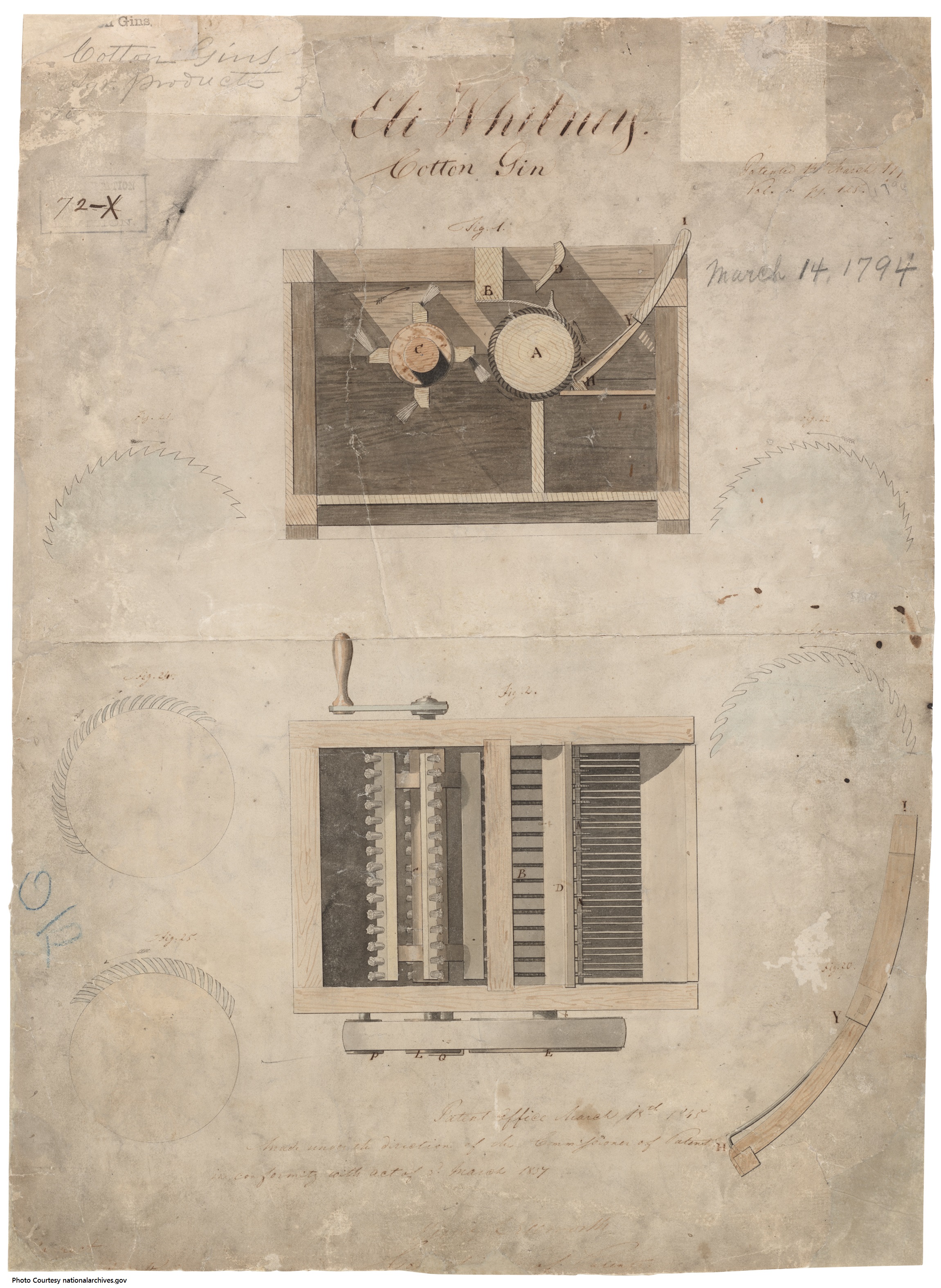
Patent of the Day: Speed Indicator
Suiter Swantz IP takes a look back at past inventions and inventors with our Patent Of The Day.
On this day in 1906, Charles Oscar Ericson was granted U.S. Patent No. 814,905 for a SPEED INDICATOR.
This invention relates to improvements in speed-indicators for wheeled vehicles, and more particularly to recording speed-indicators.
The object of this invention is to produce a very simple apparatus which can be easily attached to an automobile, wagon, car, or other wheeled vehicle and which will act easily and accurately to indicate the speed at which the vehicle is traveling, and, further, to construct and arrange the apparatus so that a record can be kept of the speed of the vehicle during a period of time.
This invention is further intended to make the apparatus simple and positive and to construct it so that it can be easily-attached to an ordinary vehicle and connected with the rotating arts thereof.
Suiter Swantz IP is a full-service intellectual property law firm serving all of Nebraska, Iowa and South Dakota. If you have any intellectual property questions or need assistance with any patent, trademark or copyright matters and would like to speak to one of our patent attorneys please feel free to contact us.

The Big Ten Sues Self-Help Co. for TM Infringement
It’s March, the time for college basketball enthusiasts to revel in the NCAA Men’s Basketball March Madness®, and as many of these enthusiasts know, the madness can happen on and off the court.
In addition to filling out brackets, the Big Ten Conference is filling out paperwork to protect its trademark against infringers, specifically a company named B10xB. The Big Ten Conference filed a complaint in the U.S. District Court for the Eastern District of North Carolina against B10xB and its principal shareholder Cesar L. Rodriguez. The Big Ten Conference alleged Rodriguez’s company infringed on their trademark registrations with a “confusingly similar” name that is used in connection with a domain name, online seminars, training modules and an upcoming merchandise line.
B10xB is an online organization with multiple social media accounts that encourages their members to be “fearless, bolder & more badass.” According to the company’s Facebook page, the moniker B10xB stands for “Be Ten Times Bolder”. Their mission statement is- “B10xB = Be Ten Times Bolder! Our mission is to help you transform you into the ten times bolder version of yourself you were born to be so you can dominate, conquer, and accomplish anything you go for ... without feeling fear, anxiety or apprehension.”
The Big Ten Conference, which has operated under the name “Big Ten” since 1917, was alerted to Rodriguez’s trademark application in February of 2016, when he filed for the name B10xB to appear on clothing and merchandise such as hats, hoodies, pants, rubber bracelets, and other clothing articles.
The Big Ten Conference alleged that the defendants knowingly and intentionally infringed on their trademarks which has led to consumer confusion as to the Big Ten’s affiliation with B10xB. The Big Ten has tried to contact Rodriguez multiple times and has “gone to great lengths to resolve this matter amicably.” These efforts included emails and five cease and desist letters, one of which was sent as early as April 13, 2016. The other four were sent in May, June, July, and November of 2016, with the final letter containing a drafted complaint. The original letter requested Rodriguez abandon the trademark application and cease use of any and all B10xB marks in connection with merchandise and services. It also requested the transfer of the website domain to the Big Ten.
Although Rodriguez did not respond to the letters, he did acknowledge the attempts to contact him via email. He said the emails he received looked like spam and he did not open them as to avoid the potential for a virus to his computer. He also told the Big Ten his “attorney’s [sic] will be in touch with you regarding this matter.” The complaint stated that Rodriguez has continually avoided contact and “no attorneys for defendants ever contacted counsel for the conference, nor did Mr. Rodriguez provide their contact information.”
The Big Ten Conference feels that the ”[d]efendants’ unauthorized uses of the Big Ten Marks are likely to cause, have caused, and continue to cause dilution of the famous Big Ten Marks by eroding the public’s exclusive association of the famous Big Ten Marks with the Conference and by lessening the capacity of the famous Big Ten Marks to identify and distinguish the Conference’s goods and services.”
The Big Ten Conference is seeking action for an injunction and monetary damages due to Rodriguez’s willful infringement on the trademark.
Suiter Swantz IP is a full-service intellectual property law firm serving all of Nebraska, Iowa and South Dakota. If you have any intellectual property questions or need assistance with any patent, trademark or copyright matters and would like to speak to one of our patent attorneys please feel free to contact us.
Patent of the Day: Alternating Electric Current Generator
Suiter Swantz IP takes a look back at past inventions and inventors with our Patent Of The Day.
On this day in 1891, Nikola Tesla was granted U.S. Patent No. 447,921 for an ALTERNATING ELECTRIC CURRENT GENERATOR.
In the systems of distribution of electrical energy from alternating-current generators in present use the generators give ordinarily from one to three hundred alternations of current per second. I have recognized and demonstrated in practice that it is of great advantage, on many accounts, to employ in such systems generators capable of producing a very much greater number of alternations per second-say fifteen thousand per second or many more. To produce such a high rate of alternation, it is necessary to construct a machine with a great number of poles or polar projections; but such construction, on this account, in order to be efficient, is rendered difficult. If an armature without polar projections be used, it is not easy to obtain the necessary strength of field, mainly in consequence of the comparatively great leakage of the lines of force from pole to pole. If, on the contrary, an armature-core formed or provided with polar projections be employed, it is evident that a limit is soon reached at which the iron is not economically utilized, being incapable of following without considerable loss the rapid reversals of polarity. To obviate these and other difficulties, I have devised a form of machine embodying the following general features of construction.
I provide a field-magnet core made up of two independent parts formed with grooves for the reception of one or more energizing coils. The energizing coil, or coils, is completely surrounded by the iron core, except on one side, where occurs the opening between the polar faces of the core, which opening is made as narrow as the conditions of the machine will permit. The polar faces of the core of the field are not smooth, but formed with a great many projections or serrations, the points of which in one side or polar face are preferably exactly opposite those in the other. Between the faces so formed I mount or support the armature coil or coils and provide either for rotating the field-magnet or the armature, or both, and I arrange the said armature-coil or conductor so that it will be symmetrically disposed with respect to the field-that is to say, so that when one portion of the conductor is passing through the strongest portion of the field the other portion, which forms the return for the former, is passing through the weakest points or parts of the field. The strongest points of the field, it will be understood, are those between the projections or points on the polar faces, while the weakest points lie midway between them.
A field-magnet, when constructed as above described, produces, when the energizing-coil is traversed by a continuous current, a field of great strength, and one which maybe made to vary greatly in intensity at points not farther distant from one another than the eighth of an inch. In a machine thus constructed there is comparatively little of that effect which is known as “magnetic leakage,” and there is also but a slight armature reaction. Either the armature-conductor or the field magnet may be stationary while the other rotates, and as it is often desirable to maintain the conductors stationary and to rotate the field-magnet I have made a special modification of the construction of the machine for this purpose, and with a view in such case of still further simplifying the machine and rendering it more easy to maintain in operation I arrange the armature-conductors and the frame or supports therefor so as to support also a fixed coil or coils for energizing the rotating field-magnet, thus obviating the employment of all sliding contacts.
Suiter Swantz IP is a full-service intellectual property law firm serving all of Nebraska, Iowa and South Dakota. If you have any intellectual property questions or need assistance with any patent, trademark or copyright matters and would like to speak to one of our patent attorneys please feel free to contact us.
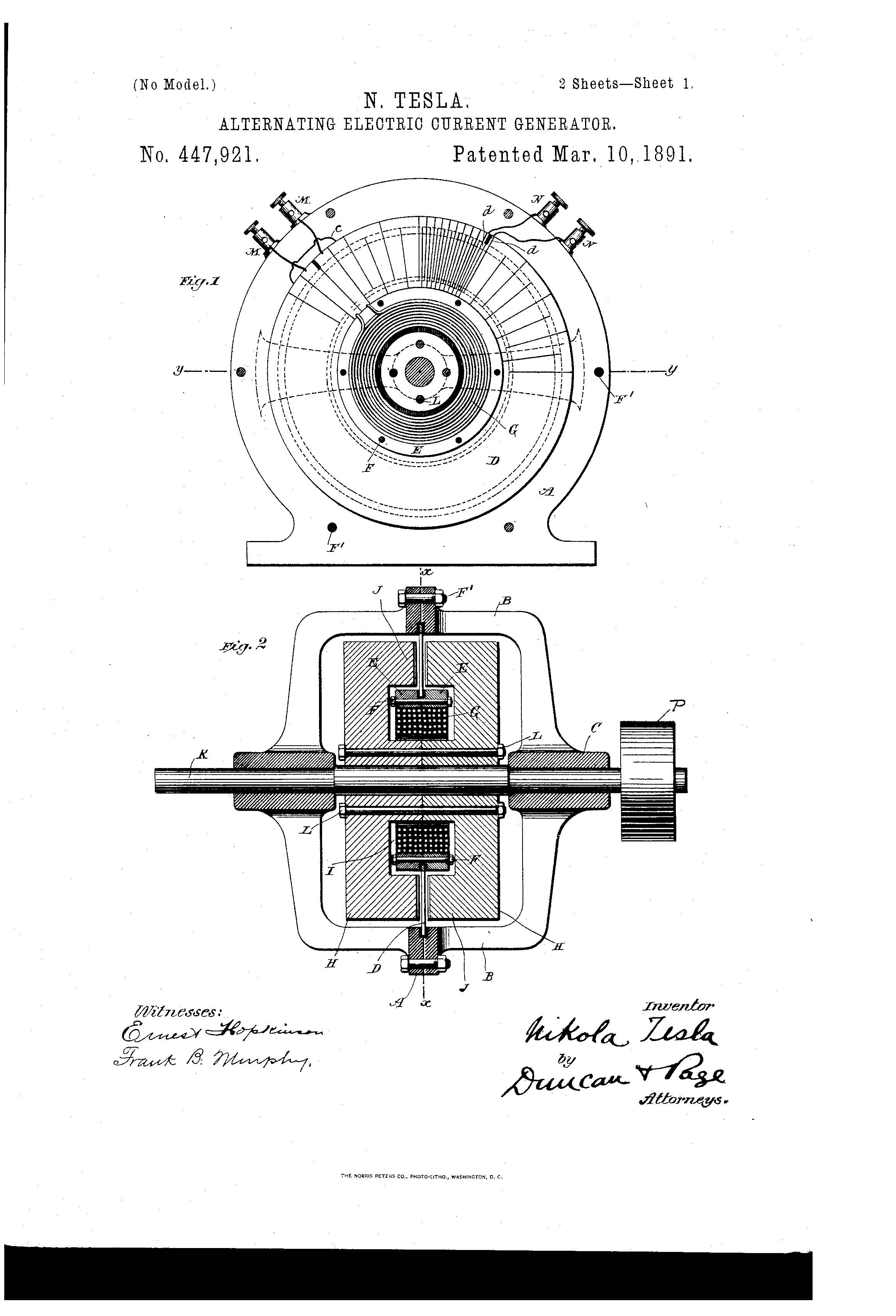
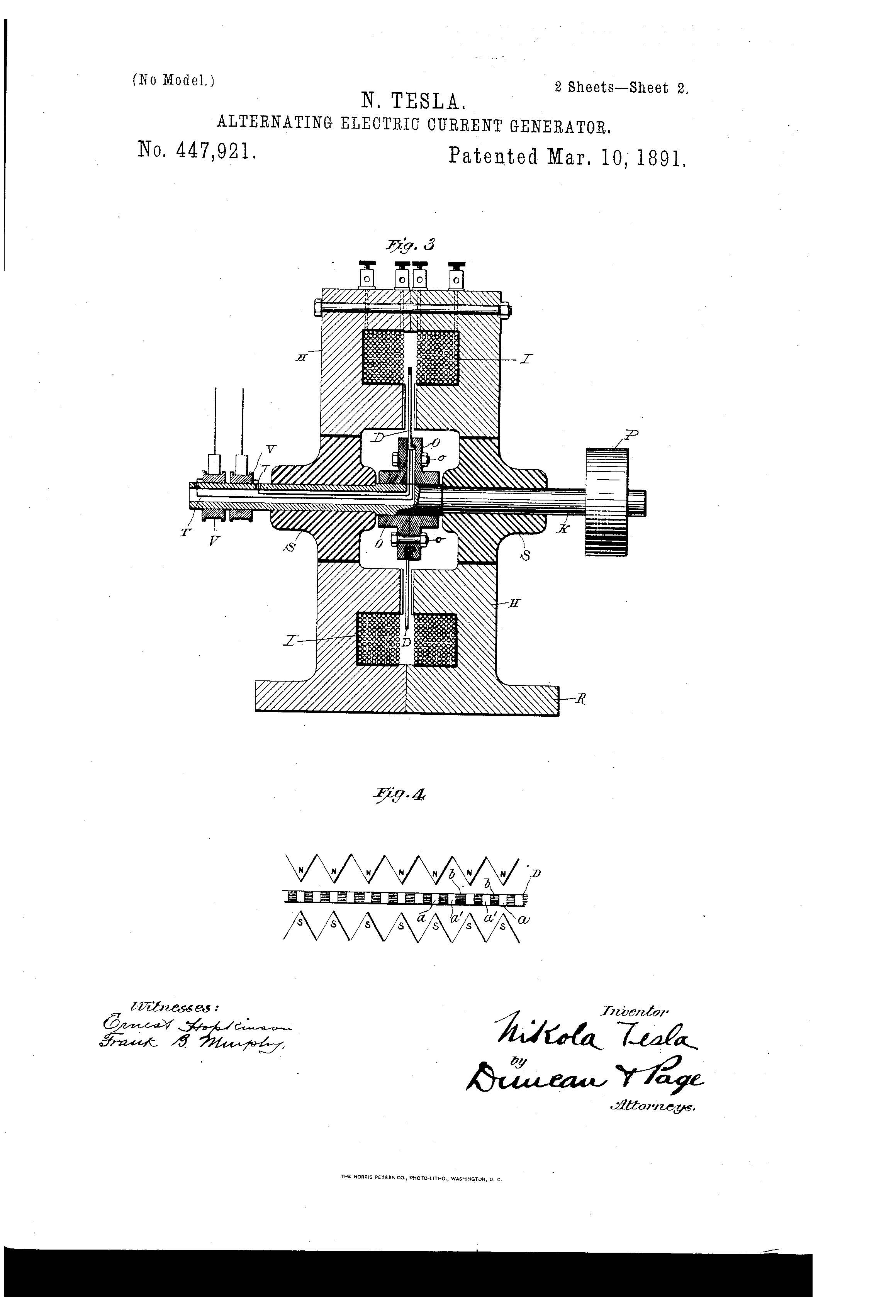
Patent of the Day: Gas Mask and Helmet
ioofgrandlodgeofohio.org buy cialis online Suiter Swantz IP takes a look back at past inventions and inventors with our Patent Of The Day.
On this day in 1954, Paul Charbonnel was granted U.S. Patent No. 2,671,445 for a GAS MASK AND HELMET.
The present invention has for its object the embodiment of a system adapted to protect against gases and noxious dust and it comprises, on the one hand, a mask enabling the easy breathing and a good visibility for the attendant and, on the other hand, a helmet designed so as to allow the easy wearing of said mask together with its accessories.
This application is a continuation of Serial No. 692,050, filed jointly by Paul Charbonnel and Robert Raymond Jegou on August 21, 1946.
The invention further refers to the embodiment of a system of the aforesaid type in which the user is handicapped neither by the wearing of the filtering means-or the respirable air container—nor by the duct connecting these filtering means—or this container—with the protecting mask.
The invention has also for object the execution of a mask that may be applied in an air-tight manner on the face of the wearer, without on this account calling for means liable to compress the neck and the carotid.
A further object of the invention is to execute a helmet allowing, on one hand, the wearing of the filtering means either on the back or above the head of the user and, on the other hand, the yielding ducts which connect the mask to the filtering means or the breathable air container, to pass through the very helmet.
Still another object of the invention is executing a mask which enables the wearer to use optical instruments like correcting glasses, without being embarrassed by said mask.
Still a further object of the invention is the execution of an exhaust valve enabling to breathe out easily, that insures a perfect tightness during inhaling, and allows easy transmitting of speech for instance by the use of a telephone.
The different objects mentioned above are covered in accordance with the invention:
By the fact that the mask is formed by a yielding peripheral part connected in a tight manner to a rigid face member shaped according to the form of the face, to which it comes very near, and said face member—made preferably of molded material—is adapted to come into contact with the face of the wearer at three points. only, namely: the forehead and both cheek-bones;
By the fact that the valve provided for the exhaust of used air has a great diameter (superior to half the distance separating the nose from the chin), is of great suppleness and is arranged so as to form a diaphragm for transmitting sounds;
By the fact that the helmet adapted to be worn with the mask is provided with a recess for the yielding duct connecting the mask with the filtering capsule and the latter may in an advantageous form of execution be located above the head of the wearer where it is fixed in a detachable way, for instance by means of a bayonet joint, to the securing straps of the mask and fits freely in a recess of said helmet; the wearer may thus remove the helmet while keeping on to use the actual breathing device.
The system moreover includes a box for carrying the mask and its auxiliaries, and said box is shaped so as to be easily adapted on the upper part of the back of the wearer.
Suiter Swantz IP is a full-service intellectual property law firm serving all of Nebraska, Iowa and South Dakota. If you have any intellectual property questions or need assistance with any patent, trademark or copyright matters and would like to speak to one of our patent attorneys please feel free to contact us.





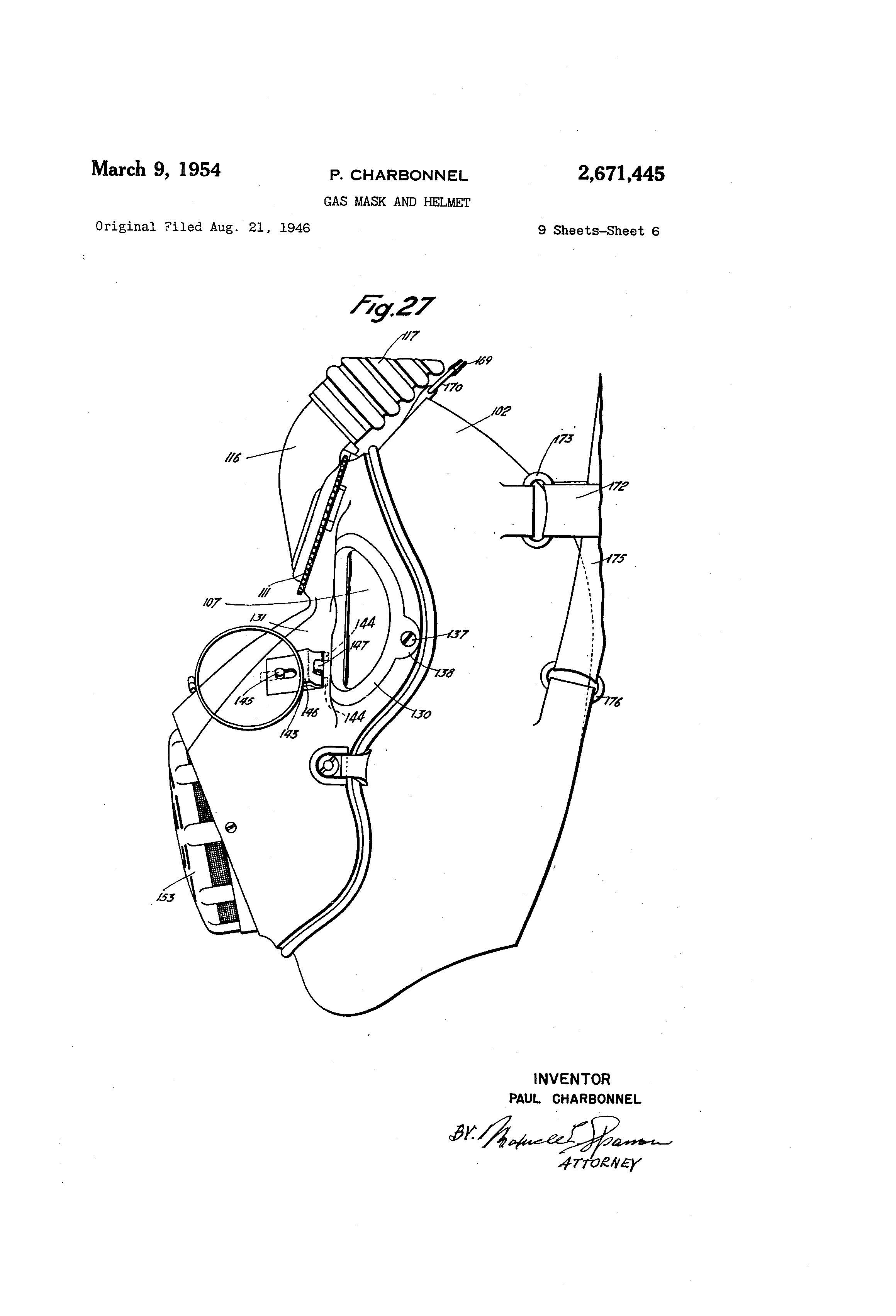



Apple Dodges $533M Judgment
On March 1, 2017, the United States Court of Appeals for the Federal Circuit (CAFC) unanimously tossed out a jury verdict that had previously required Apple Inc. to pay Smartflash LLC $533 million. Smartflash, a technology developer and licenser, claimed that their data storage patents were infringed by Apple’s iTunes software.
In 2015, a federal jury in the Eastern District of Texas found that Apple’s iTunes used software that infringed Smartflash’s patents (U.S. Patent Nos. 7,334,720, 8,118,221, 8,336,772). Smartflash argued that Apple’s infringement came after inventor Peter Racz, executive for Smartflash, met with the highly sought after software designer, Austin Farrugia. At the time of the meeting, Farrugia was working for a European company but later joined Apple to design security programs for the iTunes store. After hearing arguments in the case, the jury awarded Smartflash $532.9 million in damages. Apple immediately announced its plans to appeal and in a printed statement said "Smartflash makes no products, has no employees, creates no jobs, has no US presence and is exploiting our patent system to seek royalties for technology Apple invented."
Apple filed a motion for summary judgement with the magistrate of the District Court that sought invalidity of all asserted claims under §101. The magistrate recommended the motion be denied and the District Court adopted the recommendation and found the claims not invalid under §101. With the claims being directed to patent-eligible subject matter, the District Court applied the Supreme Court’s Alice Corp, v. CLS Bank Int’l’s two-step framework for determination of patent eligibility.
When the case was heard by the CAFC, they began their analysis at step one of Alice, whether the claims are “directed to” an abstract idea. The District Court concluded that the claims were directed to the abstract idea of “conditioning and controlling access to data based on payment.” When reviewing the material, the CAFC asked “whether the focus of the claims is on the specific asserted improvement in computer capabilities . . . or, instead, on a process that qualifies as an ‘abstract idea’ for which computers are invoked merely as a tool.” They found the asserted claims are directed to the abstract idea of conditioning and controlling, affirming the District Court’s conclusion.
The CAFC next addressed step two of Alice, whether the claims recite any “inventive concept” sufficient to “‘transform the nature of the claim’ into a patent-eligible application.” The District Court found the claims are patent-eligible because they purportedly recite “specific ways of managing access to digital content data based on payment validation through storage and retrieval of use of status data and use rules in distinct memory types and evaluating the use of data according to the rules.” The Supreme Court and the CAFC have previously held that such routine computer activities are insufficient for conferring patent eligibility. As such, they did not find the claims “‘transform[ed] the nature of the claim’ into a patent-eligible application.”
Smartflash argued that the asserted claims are akin to the claims found in patent-eligible DDR Holdings, LLC v. Hotels.com, L.P. and Ultramercial. The CAFC found Smartflash’s asserted claims recite reading, receiving, and responding to payment validation data and, based upon the amount of payment, and access rules, allowing access to multimedia content and “is precisely the type of Internet activity that we found ineligible in Ultramercial.”
Smartflash further argued that its claims are patent eligible because the claim elements, when considered as an ordered combination, recite specific hardware components. The CAFC found the hardware components are all generic computer components and do not, taken individually or as an ordered combination, “transform [the] abstract idea into a patent-eligible invention.”
Judge Sharon Prost stated “the asserted claims are all directed to the abstract idea of conditioning and controlling access to data based on payment, and fail to recite any inventive concepts sufficient to transform the abstract idea into a patent-eligible invention. As such, the asserted claims are all invalid for failing to recite patent-eligible subject matter under 35 U.S.C. § 101.”
Judge Prost further stated “[b]ecause we find all asserted claims invalid, we do not reach the remaining issues raised on appeal. For the foregoing reasons, the district court’s decision is reversed.”
Click here to read the full opinion.
Suiter Swantz IP is a full-service intellectual property law firm serving all of Nebraska, Iowa and South Dakota. If you have any intellectual property questions or need assistance with any patent, trademark or copyright matters and would like to speak to one of our patent attorneys please feel free to contact us.
Patent of the Day: Shirt Ironing Table
Suiter Swantz IP takes a look back at past inventions and inventors with our Patent Of The Day.
On this day in 1881, Rudolph Brenner was granted U.S. Patent No. 238,482 for a SHIRT IRONING TABLE.
This invention is an improved shirt-ironing device. Its object is to provide a board upon which the bosoms and neck-bands of shirts may be ironed. Its object is also to provide a convenient means to stretch and hold the bosom smooth while it is ironed.
Suiter Swantz IP is a full-service intellectual property law firm serving all of Nebraska, Iowa and South Dakota. If you have any intellectual property questions or need assistance with any patent, trademark or copyright matters and would like to speak to one of our patent attorneys please feel free to contact us.

Patent of the Day: Gate
Suiter Swantz IP takes a look back at past inventions and inventors with our Patent Of The Day.
On this day in 1905, William Kiddoo was granted U.S. Patent No. 784,404 for GATE.
This invention relates to gate construction,and more particularly to that variety thereof which is designed to be opened from either side without the necessity of alighting; and this invention consists of certain novel features of combination and construction of parts, the preferred form whereof will be hereinafter clearly set forth, and pointed out in the claim.
The prime object of this invention is to provide a gate of the character specified which consists of the fewest number of operating parts and which, therefore, may be very cheaply manufactured, it being understood that the simplicity involved in no wise interferes with the efficiency of my gate.
A further object, among others is to provide an automatically-controlled latch or keeper, whereby the gate will be locked in a closed position and prevented from being casually opened, as by stock rubbing against the same.
Suiter Swantz IP is a full-service intellectual property law firm serving all of Nebraska, Iowa and South Dakota. If you have any intellectual property questions or need assistance with any patent, trademark or copyright matters and would like to speak to one of our patent attorneys please feel free to contact us.



Patent of the Day: Sun Glasses, Goggles, and the Like
Suiter Swantz IP takes a look back at past inventions and inventors with our Patent Of The Day.
On this day in 1953, Paul Astruck was granted U.S. Patent No. 2,628,352 for SUNGLASSES, GOGGLES AND THE LIKE.
This invention relates to sun glasses, goggles and the like for the eyes in which the eye-pieces are hingedly mounted in a frame so as to be movable in the frame to be over the eyes or at various upward angles in front of the eyes, and has for its object to construct such type of sun glasses, goggles or the like in an improved manner.
According to this invention, a pair of sun glasses, goggles or the like comprises a frame with hingedly connected ear-pieces, a bridge for the nose, and flexible eye-pieces hingedly connected to the frame on short projections such as lugs or pins on the frame engaging in sockets such as recesses or holes in the side edges of the eye-pieces, or by short lugs or pins on the eye-pieces engaging in holes or recesses in the frame.
Preferably the eye-pieces are of greater width than the eye-piece openings so that when engaged on the lugs or pins the eye-pieces are slightly concave and under tension.
Suiter Swantz IP is a full-service intellectual property law firm serving all of Nebraska, Iowa and South Dakota. If you have any intellectual property questions or need assistance with any patent, trademark or copyright matters and would like to speak to one of our patent attorneys please feel free to contact us.

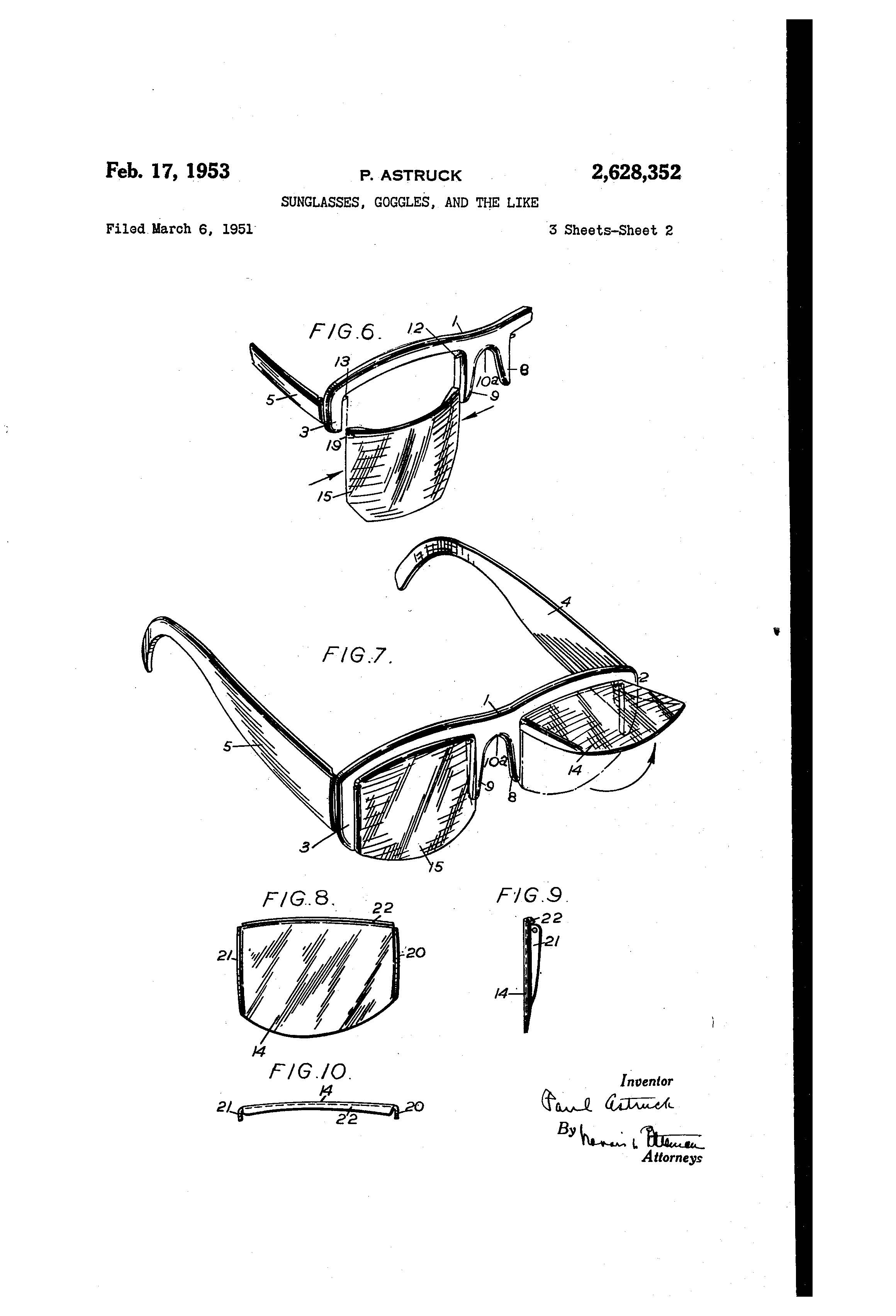
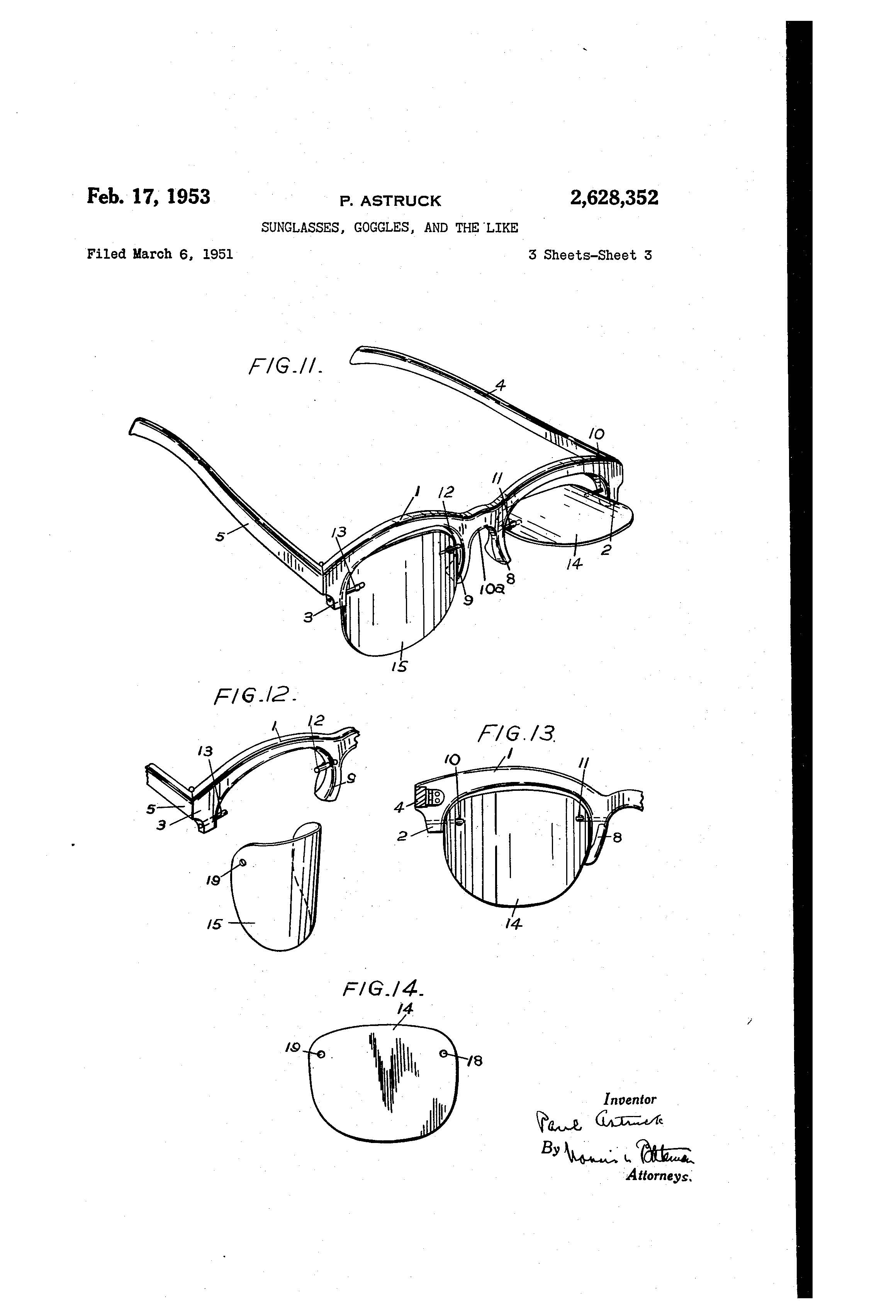
Patent of the Day: Imitation Marble and Granite
Suiter Swantz IP takes a look back at past inventions and inventors with our Patent Of The Day.
On this day in 1909, George Payne was granted U.S. Patent No. 880,753 for IMITATION MARBLE AND GRANITE.
The object of this invention is to produce imitation marble or granite blocks having a polished and ornamental surface made of petrefite or other similar magnesite cement. The cement may be in the form of a thin coating on a suitable backing, such as slate, wood, sheet metal, cardboard or bricks, or it may be solid in the form of tiles.
The magnesite or other similar cement is placed on a very smooth or polished surface, such as smooth or polished g ass, and pressed into close contact with the same. The backing, when such is used, is then pressed against the cement before this latter as set and adheres to the cement. When the cement has set it is removed from, the glass by slightly twisting the cement and backing with relation to the smooth surface, thereby allow in air to enter between the two surfaces. It will be found that the magnesite cement has acquired a beautiful hard polished surface. In some cases tiles, bricks or building blocks, of solid magnesite cement may be formed by forming them in molds having one or more highly polished surfaces. When desired a suitable colors may be applied to the back of the cement before placing the backing, when such is used, in contact with the cement. By these means various effects may be obtained, some representing marble or granite, as the coloring matter passes into the cement and is seen through the polished surface thereof.
Suiter Swantz IP is a full-service intellectual property law firm serving all of Nebraska, Iowa and South Dakota. If you have any intellectual property questions or need assistance with any patent, trademark or copyright matters and would like to speak to one of our patent attorneys please feel free to contact us.

Patent of the Day: Combined Table Knife and Fork
Suiter Swantz IP takes a look back at past inventions and inventors with our Patent Of The Day.
On this day in 1909, Cary H. Ruble was granted U.S. Patent No. 914,310 for a COMBINED TABLE KNIFE AND FORK.
This invention relates to a combined table fork and knife, and more particularly to a table fork provided with a rotary knife for cutting purposes.
The invention has for one of its objects to improve and simplify the construction of devices of this character so as to be comparatively simple and inexpensive to manufacture, easily and conveniently used, and so designed as not to be cumbersome or in attractive in appearance.
Another object of the invention is the provision of a fork having a slotted shank in which is mounted a cutting wheel whereby certain foods can be conveniently cut into pieces without needing the usual table knife so that one utensil serves the purpose of two.
Suiter Swantz IP is a full-service intellectual property law firm serving all of Nebraska, Iowa and South Dakota. If you have any intellectual property questions or need assistance with any patent, trademark or copyright matters and would like to speak to one of our patent attorneys please feel free to contact us.







